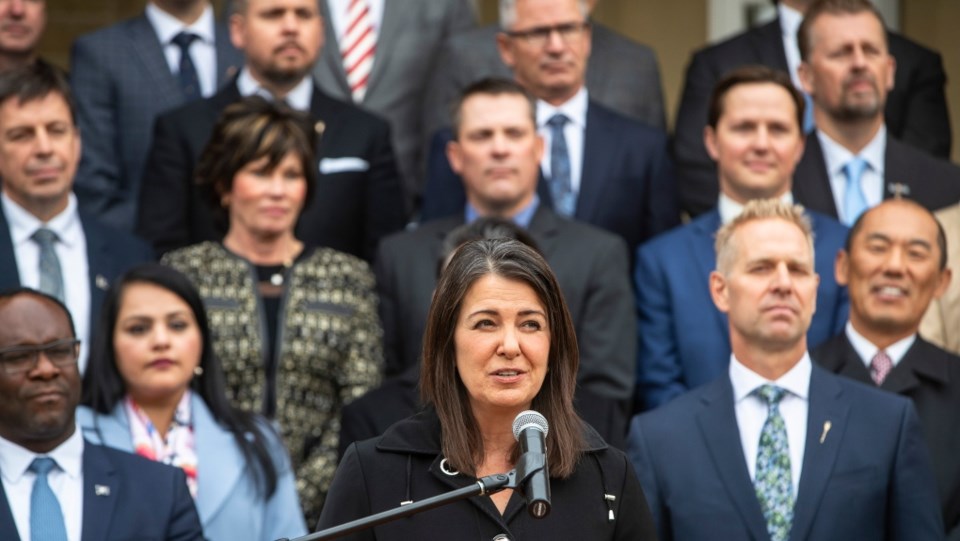Call it the mega-cabinet.
One of the curious moves by Danielle Smith when she took office in the fall was to appoint a ginormous cabinet--24 department ministers plus two ministers without portfolios and 11 parliamentary secretaries, who are like half-ministers.
This cabinet included about two-thirds of the United Conservative caucus, bloated way beyond the leaner cabinets of former premiers Jason Kenney and Rachel Notley. It was an obvious attempt by Smith to buy loyalty--using ministerial salary hikes and lofty titles--from her MLA minions, divided in the wake of a competitive party leadership race.
The swollen cabinet budget seemed to contradict Smith’s earlier pronouncements about smaller government and spending restraint.
One area where penny-pinching has been maintained up to now involves the push to reinstate the role of a seniors advocate to bring attention to issues affecting Albertans beyond middle age. The job was axed by Kenney, based on the argument it could be adequately absorbed into the office of the “health advocate,” along with a handful of staff, minus the seniors advocate herself, who was let go.
As cost-savings go, the $500,000 annual budget allotted for the seniors advocate was like pennies on the dresser for a government with a $62-billion budget. Still, calls to restore the position--from the New Democrats and several advocacy groups--have gone unheeded.
The issue may deserve another look.
Appointing a seniors advocate is perhaps not as sexy for Smith’s UCP government as protecting Alberta “sovereignty” or the unvaccinated, whom the premier said faced the most discrimination of any group in her lifetime.
No one is suggesting that reinstating the advocate position is a panacea for the plethora of challenges facing the growing grey wave. But it would help give seniors a voice.
The previous seniors advocate, Sheree Kwong See, stated publicly prior to her departure that Alberta “really needs a seniors advocate,” to ensure seniors issues remain front and centre. The Progressive Conservative government in 2013 announced it would create the role. But it did not actually become an independent office until See was recruited in 2016 after Notley and the NDP came to power.
The office was tasked with helping tackle various barriers to support programs, served as an outreach for seniors groups and made recommendations for service improvements to government. The advocate under See handled more than 3,600 calls for help and closed about 100 files per month. The 2018-2019 annual report showed only 28 per cent of calls were directly related to health care, while the remainder involved assistance with support programs, financial issues and housing.
The current health advocate, Janice Harrington, is the former executive director of the UCP, an obvious patronage appointment. Her last annual report barely mentions the word “seniors,” something that has not gone unnoticed by advocacy groups like the National Association of Federal Retirees.
“It (seniors advocate position) doesn’t exist at all anymore,” lamented Rick Brick of St. Albert, the retiree association’s Prairie district representative. “It just disappeared, went away.”
Brick and other proponents say a new seniors advocate should be modelled after the province’s child and youth advocate, which at least reports directly to the legislature rather than to a cabinet minister, making the role more independent.
Newfoundland/Labrador and British Columbia both have seniors advocates. B.C.’s played a key role during the pandemic, making recommendations that alleviated at least some of the outbreaks and turmoil faced in long-term and continuing care centres. “Sometimes they were listened to,” said Brick. “It certainly worked much better than in Alberta.”
According to the latest StatsCan figures, 725,000 of the 4.6 million people in Alberta are over the age of 65. Seniors are the fastest growing demographic, and numbers are expected to double in two decades.
Not to put too fine a point on it, there is a provincial election in May. And seniors tend to show up at the ballot box, compared to other age groups.
Just sayin’.
Ashley Geddes monitors politics for Alberta Prime Times. Over more than 45 years in journalism, he spent much of that time covering municipal, provincial and federal politics, most of it in Alberta.




